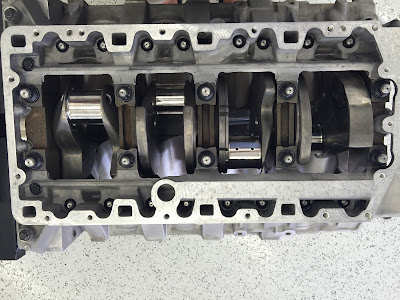Been a few weeks since I last posted about this build. An impromptu vacation and a couple of customer calibrations to finish came first. Several small things have been completed, and at this stage I'm about to drop the crankshaft into the block. Just waiting on a fresh bottle of A136 from Jerry before I can finish the bottom end.
Combustion Chamber volume: I measured the volume of the combustion chambers with a 100cc burette. Since the first build, we are using new copper-beryllium valve seats and larger intake valves, so I needed to confirm the chamber cc's to determine final compression ratio. Sealed the valves and the plexiglass overlay with white lithium grease. The results were a little surprising. the chambers measured 47cc's. (I was expecting 49cc)--the new valve job reduced the volume by 2cc's. That leaves the final compression ratio at
14.8:1. Was aiming for closer to 14:1, but will be running race fuel anyway, so not a big deal. << Update: after assembling the shortblock and taking accurate piston-to-deck measurements, the final compression is 14.55:1. The pistons are .003" above the deck at TDC.>>
Piston pin assembly: Back to the bottom end, I installed the round wire locks in one side of each piston pin bore. These locks can be tricky to install, but with a little practice and a small flat-blade screwdriver, it got a lot easier. These are .068" thick round wire locks, and were installed with the ends at 6 o'clock relative to the pin bore. A bit of assembly lube (Torco MPZ HP) on the piston pin, and ready for the other lock. It is important to get the pistons oriented correctly on the rods so that the large chamfer on the rod is facing towards the crank cheek, while the intake valve pockets also face the inside of the engine. Seems simple, but I double and triple checked this before locking the pistons to the rods.
Piston Rings: This build uses Total Seal AP steel rings. All the end gaps were set by the machinist, so I won't show that here. Top and Second end gaps were set at .019". The rings were marked specific to each individual bore, but the bore dimensions were so identical, they could have been installed in any hole and been fine. Nevertheless, I installed them in the same position they were set up for. The oil rings use a support rail because the pin bore intersects the oil ring groove. The support rail has a raised "dimple" on one side, which needs to face down and centered in the pin bore opening. The support rails were installed first, then the expander, then the two scraper rings. These are custom 3mm oil rings, at 14# tension. The second ring is .043" Napier style, so orientation is important. The top ring is .043" steel, and is installed with the inner chamfer facing up. Checked the vertical clearance between the rings and piston-- all <.0015", which is the smallest feeler gauge I have. Tight vertical clearance is expected with these high end rings and gas ports.


Crankshaft checks: One other thing I checked at this stage is the straightness of the crankshaft. I had no reason to believe there was a problem, but checked it nonetheless. This was done by placing the #1 and #5 upper main bearing shells in the block, and placing the crank into position. Using a dial indicator on the center crank journal, I rotated the crankshaft a complete revolution. There was zero measurable runout, so all is good.
The crank came back from the machinist with the threaded oil plugs removed. Using compressed air, I blew out all the oil passages. They were clean anyway, this was just a precaution before installing the plugs. The pipe plugs get a light coat of Loctite 565 sealant before being installed.
Next time I hope to install the crank and pistons and finish the bottom end.






























